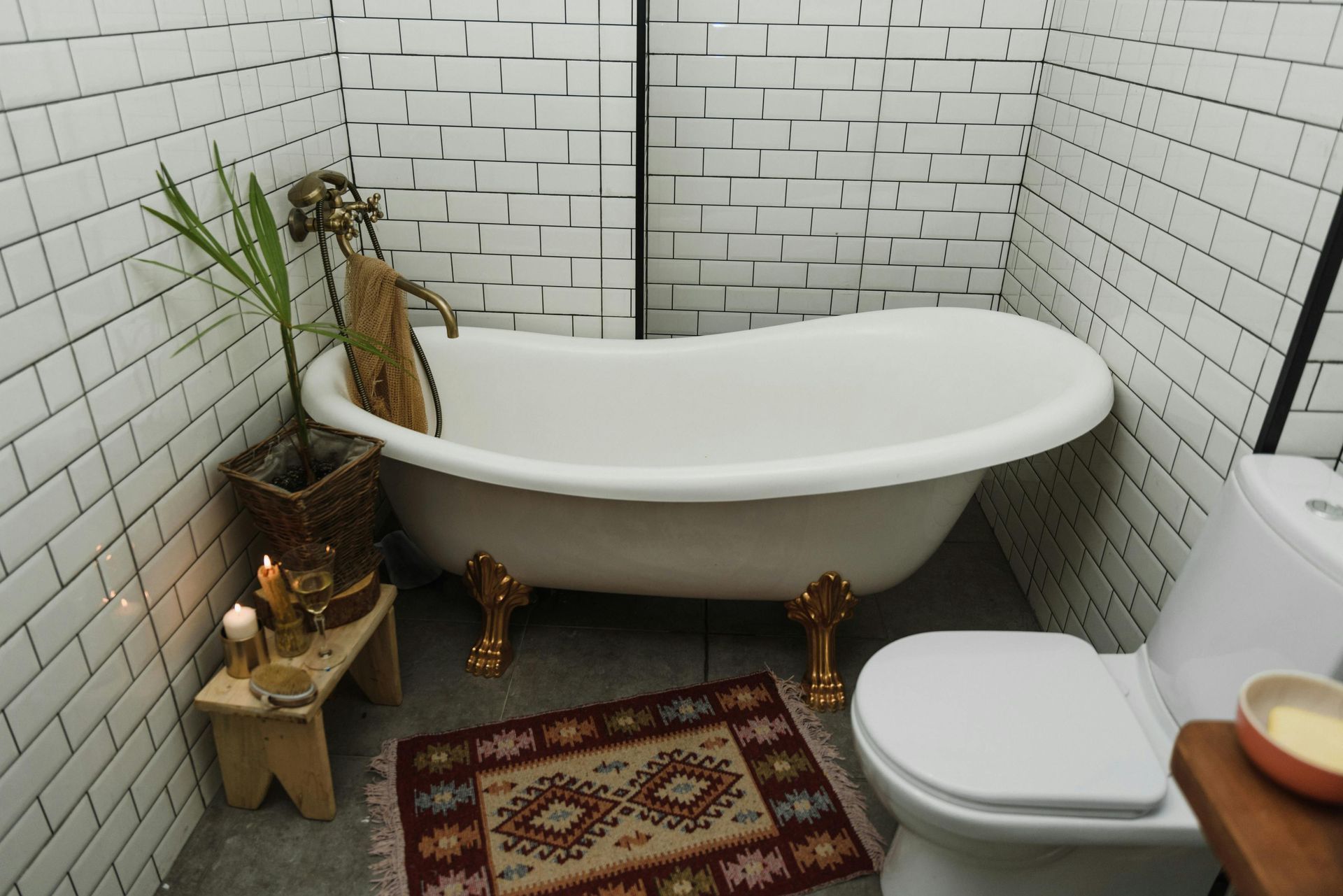Contact us
Office
The York Eco Business Centre,
7 Clifton Moor Gate,
York
YO30 4AG
hello@gw-plumbing.com
Message us
Contact Us
Latest Articles

Small bathrooms can be surprisingly tricky to design. You’ve got all the essentials to fit in; loo, sink, shower or bath, storage, and not much space to do it in. But with the right layout, you can create a bathroom that feels functional, spacious, and even a bit luxurious, no matter how compact the footprint. In the UK, many homes, especially terraces and semis (just like a lot of Yorks housing), have fairly small bathrooms, often squeezed in as part of a loft conversion or an en suite or added on to the kitchen as a later addition. That’s where clever planning really pays off. Start With What You Have Before you start sketching out dream layouts, it helps to understand the space you’re working with. Look at where the existing pipework is as moving plumbing can be costly and sometimes unnecessary. If your current layout has things more or less where they need to be, you might just need a refresh rather than a full overhaul. However sometimes a total rethink opens up space you didn’t know you had. Swapping a full-size bath for a walk-in shower can free up valuable room, and a wall-hung toilet and basin can create a more open feel by exposing more floor. Though think about use cases, will you ever want to bath children so still need a bathtub? Bathroom Layout One of the most efficient small bathroom layouts is the classic three-wall layout. This is where the toilet, basin, and bath or shower are all positioned against separate walls—usually forming a ‘U’ shape around the room. This approach maximises use of available wall space and keeps each area clearly defined. It’s practical and works particularly well in narrow bathrooms, as it allows a clear line of sight through the room, making it feel bigger. Another popular option for small bathrooms is the back-to-wall layout. Here, all the main fixtures—bath, basin, and toilet—are placed along a single wall. This approach is great for saving on plumbing costs, as everything’s in a neat line, and it keeps the floor area open, which can make the room feel more spacious. It’s ideal for rectangular rooms, especially those with the door at one end. In really tight bathrooms, using corner fixtures can be a game changer. Corner toilets and sinks help to free up central space and reduce the amount of wall that each item takes up. Similarly, quadrant shower enclosures (the ones with the curved front) are brilliant for slotting into the corner and giving you a decent showering space without a sharp edge jutting into the room. Wet Rooms are Not Just for Luxury Homes Wet rooms might seem like something you’d only see in a high-end hotel, but they can actually be a smart option in small bathrooms. By waterproofing the entire room and installing a walk-in shower with no tray or enclosure, you make full use of the space without any visual barriers. The key is good drainage and high-quality tanking (waterproofing). It’s a more involved job, but in the right property and with the right builder, a wet room can transform even the smallest boxy bathroom into something truly modern and stylish. Storage That Doesn’t Eat Space Good storage is essential in a small bathroom, but bulky cabinets or standalone units can quickly eat into precious space. Built-in storage, like recessed shelves in the wall or above a toilet cistern, keeps things tidy without cluttering the room. Mirrored cabinets are another solid choice—they do double duty by hiding away toiletries and reflecting light to make the space feel bigger. Wall mounted vanity units offer a smart compromise between storage and space saving. By lifting them off the floor, you preserve the sense of openness while still getting somewhere to stash your bits and bobs. In many UK homes, the bathroom door swings inward—usually because it’s always been that way. But in small bathrooms, that inward swing can take up vital space. Swapping to a sliding door, either pocket-style or external, can free up the area behind the door for towel rails, storage, or simply more movement space. Alternatively, a door that opens outwards (if hallway space allows) might make the room feel far less cramped. Lighting and Colour Choices Matter While layout is all about physical space, it’s worth remembering that visual space is just as important. Light colours, large-format tiles, and well-placed lighting can all contribute to the feeling of spaciousness. Use vertical lines to draw the eye upward—tall tiles or ladder-style towel warmers help here. Keep the palette light and neutral, but don’t be afraid to add contrast or a pop of colour in one area to add personality without overwhelming the room. Designing a small bathroom is all about making the most of what you’ve got. That might mean choosing a short projection toilet to save a few centimetres, or opting for a combined shower and bath unit to tick both boxes. Even little details, like fitting the towel rail above the radiator or choosing a mirrored cabinet that sits flush to the wall, can make a big difference. When space is at a premium, a well planned layout tailored to your home, lifestyle, and budget is worth every bit of time and thought.

Freestanding baths have made a serious comeback in recent years. Once considered a luxury found only in period homes an boutique hotels, they’re now found in bathrooms of all shapes and sizes. We have found that a retro roll top really suit some of the period properties around Yorkshire when combined with a sympathetic renovation. But are they a practical choice, or just a passing trend? The visual impact of a freestanding bath can’t be beat. There is something magical about the look of a smart bath with space around it. For customers looking to create a spa-like feel at home, it’s often high on the wishlist. There’s a wide variety of designs on the market, from classic roll tops with claw feet to modern, minimalist tubs with sleek lines and matte finishes. As a bathroom fitter, it’s always rewarding to install something that transforms a space so dramatically. Space needs to be a consideration. Freestanding baths usually require more room around them compared to built-in alternatives. You need clearance on all sides, not just for aesthetics, but for cleaning and maintenance too. In smaller UK homes, this can be a challenge. A bath squeezed up against a wall or radiator doesn’t just look wrong – it can be a nightmare for the homeowner when it comes to cleaning behind it or dealing with plumbing access. We would advise against this typically. Installation is another point that needs careful planning. With a standard built-in bath, pipework is typically hidden behind panels or within walls. With a freestanding model, everything’s on show or needs to be concealed beneath the floor or on show with designer pipework. This adds time and complexity to the job, and that adds cost! Floor reinforcement may also be necessary, especially for heavier cast iron baths or loft installations. Many suppliers now offer more lightweight acrylic models that are easier to install and maintain. Some even come with integrated waste and overflow systems, which can make the plumbing side a bit more straightforward. For a showpiece in a guest bathroom, a freestanding bath is a brilliant choice. For a busy family bathroom? It might not be the most practical. Another point worth noting is the taps. Wall-mounted or floor-mounted taps are common with freestanding baths but both require careful positioning. A floor mounted option in particular can add to the overall cost and complexity, especially in homes with solid floors. In the end, whether a freestanding bath is a good idea comes down to balancing style with lifestyle. As a bathroom fitter, it’s about helping homeowners make informed choices – ensuring the bath not only looks fantastic but functions well for their needs. And when done right, there’s no doubt a freestanding bath can take a bathroom from ordinary to outstanding.

